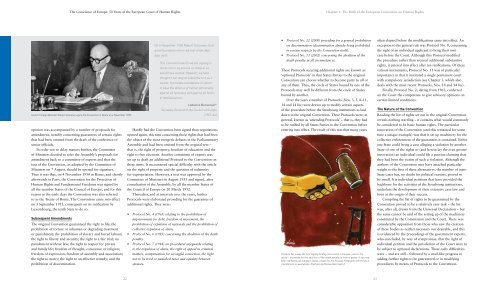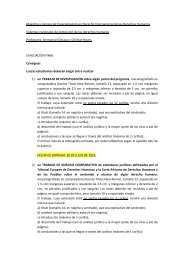Historia Corte Europea
You also want an ePaper? Increase the reach of your titles
YUMPU automatically turns print PDFs into web optimized ePapers that Google loves.
The Conscience of Europe: 50 Years of the <strong>Europea</strong>n Court of Human Rights<br />
Chapter 1: The Birth of the <strong>Europea</strong>n Convention on Human Rights<br />
French Foreign Minister Robert Schuman signs the Convention in Rome on 4 November 1950.<br />
opinion was accompanied by a number of proposals for<br />
amendment, notably concerning guarantees of certain rights<br />
that had been omitted from the draft of the conference of<br />
senior officials.<br />
In order not to delay matters further, the Committee<br />
of Ministers decided to refer the Assembly’s proposals for<br />
amendment back to a committee of experts and that the<br />
text of the Convention, as adopted by the Committee of<br />
Ministers on 7 August, should be opened for signature.<br />
Thus it was that, on 4 November 1950 in Rome, and shortly<br />
afterwards in Paris, the Convention for the Protection of<br />
Human Rights and Fundamental Freedoms was signed by<br />
all the member States of the Council of Europe, and for this<br />
reason in the early days the Convention was also referred<br />
to as the Treaty of Rome. The Convention came into effect<br />
on 3 September 1953, consequent on its ratification by<br />
Luxembourg, the tenth State to do so.<br />
Subsequent Amendments<br />
The original Convention guaranteed the right to life; the<br />
prohibition of torture or inhuman or degrading treatment<br />
or punishment; the prohibition of slavery and forced labour;<br />
the right to liberty and security; the right to a fair trial; no<br />
punishment without law; the right to respect for private<br />
and family life; freedom of thought, conscience or religion;<br />
freedom of expression; freedom of assembly and association;<br />
the right to marry; the right to an effective remedy; and the<br />
prohibition of discrimination.<br />
On 4 November 1950 Robert Schuman, that<br />
great <strong>Europea</strong>n whom we lost a few days<br />
ago, said:<br />
This Convention which we are signing is<br />
not as full or as precise as many of us<br />
would have wished. However, we have<br />
thought it our duty to subscribe to it as it<br />
stands. It provides foundations on which<br />
to base the defence of human personality<br />
against all tyrannies and against all forms<br />
of totalitarianism.<br />
Lodovico Benvenuti*<br />
Secretary General of the Council of Europe<br />
(1957–64)<br />
Hardly had the Convention been signed than negotiations<br />
opened again, this time concerning those rights that had been<br />
the object of the most energetic debates in the Parliamentary<br />
Assembly and had been omitted from the original text –<br />
that is, the right of property, freedom of education and the<br />
right to free elections. Another committee of experts was<br />
set up to draft an additional Protocol to the Convention on<br />
these items. It encountered special difficulty with the article<br />
on the right of property and the question of indemnity<br />
for expropriation. However, a text was approved by the<br />
Committee of Ministers in August 1951 and signed, after<br />
consultation of the Assembly, by all the member States of<br />
the Council of Europe on 20 March 1952.<br />
Thereafter, and at intervals over the years, further<br />
Protocols were elaborated providing for the guarantee of<br />
additional rights. They were:<br />
• Protocol No. 4 (1963) relating to the prohibition of<br />
imprisonment for debt, freedom of movement, the<br />
prohibition of expulsion of nationals and the prohibition of<br />
collective expulsion of aliens.<br />
• Protocol No. 6 (1983) concerning the abolition of the death<br />
penalty.<br />
• Protocol No. 7 (1984) on procedural safeguards relating<br />
to the expulsion of aliens, the right of appeal in criminal<br />
matters, compensation for wrongful conviction, the right<br />
not to be tried or punished twice and equality between<br />
spouses.<br />
• Protocol No. 12 (2000) providing for a general prohibition<br />
on discrimination (discrimination already being prohibited<br />
in certain respects by the Convention itself).<br />
• Protocol No. 13 (2002) concerning the abolition of the<br />
death penalty in all circumstances.<br />
These Protocols securing additional rights are known as<br />
‘optional Protocols’ in that States Parties to the original<br />
Convention can choose whether to become party to all or<br />
any of them. Thus, the circle of States bound by one of the<br />
Protocols may well be different from the circle of States<br />
bound by another.<br />
Over the years a number of Protocols (Nos. 3, 5, 8–11,<br />
14 and 14 bis) were drawn up to modify certain aspects<br />
of the procedure before the Strasbourg institutions as laid<br />
down in the original Convention. These Protocols were, in<br />
general, known as ‘amending Protocols’ – that is, they had<br />
to be ratified by all States Parties to the Convention before<br />
entering into effect. The result of this was that many years<br />
Protocol No. 6 was the first legally binding instrument in Europe – and in the<br />
world – to provide for the abolition of the death penalty in time of peace. It has now<br />
been ratified by all member States, except for the Russian Federation which has a<br />
moratorium on executions. (Cartoon by Nicolas Herrmann.)<br />
often elapsed before the modifications came into effect. An<br />
exception to the general rule was Protocol No. 9, concerning<br />
the right of an individual applicant to bring their own<br />
case before the Court. Although this Protocol modified<br />
the procedure rather than secured additional substantive<br />
rights, it entered into effect after ten ratifications. Of these<br />
various instruments, Protocol No. 11 was of particular<br />
importance in that it instituted a single permanent court<br />
with compulsory jurisdiction (see Chapter 3, which also<br />
deals with the most recent Protocols, Nos. 14 and 14 bis).<br />
Finally, Protocol No. 2, dating from 1963, conferred<br />
on the Court the competence to give advisory opinions on<br />
certain limited conditions.<br />
The Nature of the Convention<br />
Reading the list of rights set out in the original Convention<br />
reveals nothing startling – it contains what would commonly<br />
be considered to be basic human rights. The particular<br />
innovation of the Convention (and this remained for some<br />
time a unique example) was that it set up machinery for the<br />
collective enforcement of the guarantees it contained. Either<br />
one State could bring a case alleging a violation by another<br />
State of one of the rights or (and herein lay the even greater<br />
innovation) an individual could file a petition claiming that<br />
they had been the victim of such a violation. Although the<br />
authors of the Convention may have attached particular<br />
weight to the first of these alternatives, the number of inter-<br />
State cases has, no doubt for political reasons, proved to<br />
be small. It is individual petitions that have provided the<br />
backbone for the activities of the Strasbourg institutions,<br />
underlain the development of their extensive case-law and<br />
been at the origin of their success.<br />
Compiling the list of rights to be guaranteed by the<br />
Convention proved to be a relatively easy task – the list<br />
was, after all, drawn from the Universal Declaration – but<br />
the same cannot be said of the setting up of the machinery<br />
constituted by the Commission and the Court. There was<br />
considerable opposition from those who saw the creation<br />
of these bodies as neither necessary nor desirable, and this<br />
is evidenced by the proceedings of the government experts,<br />
who concluded, by way of compromise, that the right of<br />
individual petition and the jurisdiction of the Court were to<br />
be subject to optional declarations. These early difficulties<br />
were – and are still – followed by a snail-like progress in<br />
adding further rights to be guaranteed or in modifying<br />
procedures by means of Protocols to the Convention.<br />
22 23





